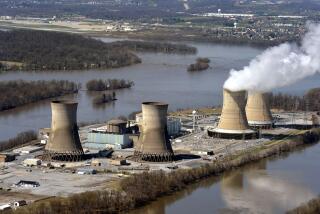U.S. Sees Restart of Reactor That Makes Tritium
WASHINGTON — Energy Secretary James D. Watkins said Tuesday that in the next few weeks he expects to approve restarting the controversial K nuclear reactor in Savannah River, Ga., which produces the radioactive tritium that is crucial to the hydrogen bomb.
The 37-year-old reactor, the only source of tritium left in the United States, was shut down in 1988 for safety modifications and modernization that cost nearly $1 billion. But a restart attempt last December led to the leakage of 150 gallons of radioactive cooling water and revived demands by environmentalists and other critics that the reactor be scrapped.
The Pentagon and Energy Departments contend that the K reactor, with the leak now corrected, is needed as a reserve source for tritium production for the next decade, despite the end of the Cold War and the availability of tritium from nuclear weapons that are being retired.
Watkins also told a House Armed Services subcommittee that:
--While his department’s $12-billion budget for next year remains essentially the same as last year, some $1 billion has been moved from weapons-related work to environmental restoration projects.
--Underground testing continues to be necessary to increase safety and ensure that the U.S. nuclear arsenal is reliable. Testing has uncovered weapon vulnerabilities and deficiencies that could not be predicted with computers, he said. He cited “a dramatic example” in which the warhead for air-launched cruise missiles exploded with only a fraction of its expected yield after being subjected to extremely low temperatures.
Although the United States is not producing new nuclear weapons, Watkins said, the tritium in existing weapons must be periodically replenished because it decays naturally at a rate of 5.5% a year.
The tritium recovered from retired weapons is expected to be sufficient until the year 2005, according to various estimates, when a new tritium-producing facility is expected to be ready.
But the Energy Department wants the K reactor tested this year and placed on standby next year, for use in the interim, if needed. It would take five to six years to bring it from standby to full production, Watkins said.
More to Read
Sign up for Essential California
The most important California stories and recommendations in your inbox every morning.
You may occasionally receive promotional content from the Los Angeles Times.










